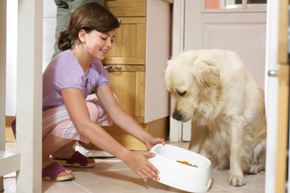No sensible person would feed a newborn baby the same diet as an adult. Indeed, our nutritional needs change dramatically depending on our life stage, including youth, adulthood, pregnancy and old age. And the same goes for dogs. A puppy has different nutritional requirements from an adult dog, a reproducing dog and an older dog. And, as a pet owner, you'll have to take account of these changes and adjust the diet as necessary.
First, it's important to be aware of the basics of a dog's diet. All dogs need an adequate amount of six things to thrive: protein, fatty acids, carbohydrates, minerals, vitamins and water. Proteins provide amino acids. Of the 22 amino acids protein can supply, 10 of these are essential, because the dog can't synthesize on its own. In addition to making food more appetizing, fats provide several nutritional benefits. They help maintain a healthy skin and coat, and are important for digesting fat-soluble vitamins. Although dogs are omnivores and can survive well enough on a vegetarian diet, it will have to include plenty of protein and fats. Experts generally agree that dogs thrive best with a diet that includes meat because of their need for protein and fats.
Advertisement
Carbohydrates, along with proteins and fats, provide for a dog's energy needs. They consist primarily of sugars, starches and cellulose. Cereals and legumes account for much of the sources of carbs in dog food. Dogs need vitamins, specifically A, B, D, E and K, for chemical reactions. Minerals, like calcium, phosphorus, magnesium and sulfur, are also required for various chemical reactions in the body. Water is most important of all and is essential for nearly every bodily function.
Keep in mind as we go through the different phases that nutritional needs depend not only on life stage, but also on a host of other factors, like breed, size and state of health.
Advertisement





